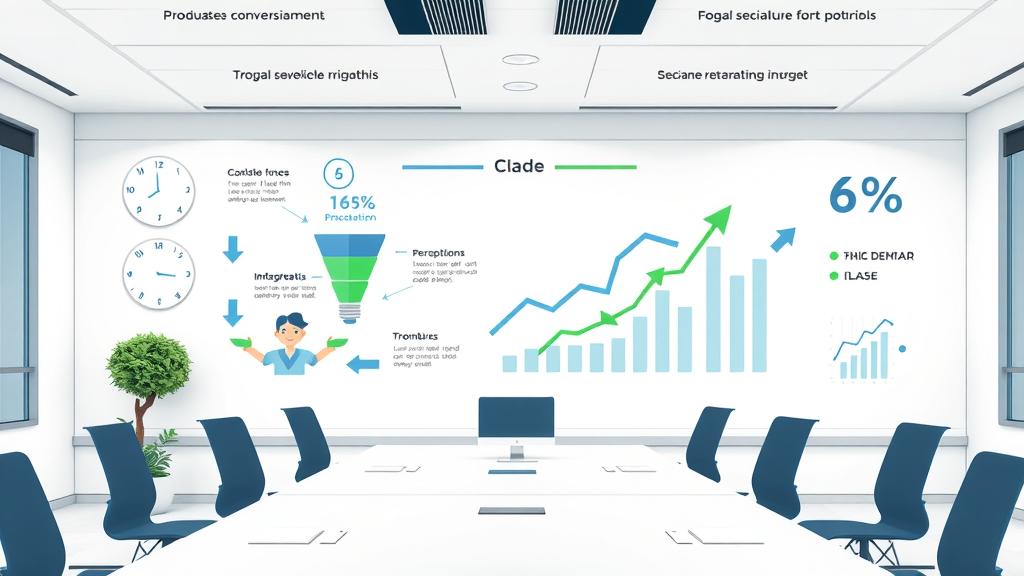Did you know that companies deploying advanced conversion tracking are 2.5x more likely to see remarkable improvements in ROI? If your digital advertising feels like a black hole, you’re not alone. Many marketers set up Google Ads campaigns and hope for the best, but without robust conversion tracking in place, crucial insights slip through the cracks—leaving your budget and strategy uncertain. This guide will transform your outcomes by teaching you how to master conversion tracking for serious results.

A Startling Truth: Why Conversion Tracking is the Backbone of Google Ads Success
The success of your Google Ads campaigns hinges on more than just clever copy and attractive visuals. The real engine is conversion tracking—it’s what separates guesswork from smart, data-driven decision-making. Let’s face it: without effective conversion tracking, every ad click is a shot in the dark. Marketers utilizing advanced tracking find that every dollar is accountable, every tactic adjustable, and every success repeatable. By making sense of conversion data, you gain clarity on what ads or keywords drive meaningful actions—like a purchase event, sign-up, or site visit—enabling measurable growth.
The proof is in the numbers: brands using robust conversion tracking are not only tracking conversions more accurately but are gaining up to double the conversion rate from their ad spend. This is because conversion tracking enables precise optimization and resource allocation. If you’re operating a new ads account or scaling an established one, understanding which ad strategies are delivering real value is the only way to maximize your ad investment. With conversion measurement tools like Google Tag Manager and Events Manager, you’ll identify and amplify your best-performing strategies for sustainable growth.
Conversion Tracking: Surprising Statistics That Highlight Its Importance
"Companies using advanced conversion tracking are 2.5x more likely to see significant improvements in ROI." — Digital Marketing Association
These eye-opening statistics underscore the impact of robust conversion tracking setup and regular analysis. Whether you’re tracking conversion actions with Google Tag or evaluating a purchase event on your landing page, optimized conversion tracking will quickly outpace traditional methods—turning educated guesses into actionable intelligence.
What You'll Learn About Conversion Tracking
- Understand what conversion tracking is and why it matters
- Learn step-by-step how to set up conversion tracking in Google Ads
- Explore how to use Google Tag Manager and Events Manager for conversions
- Identify best practices for effective conversion measurement
- Troubleshoot common conversion tracking issues
- Discover ways to optimize your ads conversion strategy

What is Conversion Tracking? (People Also Ask)
Conversion Tracking Explained: Key Concepts & Definitions
| Term | Definition |
|---|---|
| Conversion Tracking | A method to monitor and measure user actions (conversions) on your website or app after engaging with an ad. |
| Google Ads Conversion | A recorded action from your Google Ads campaigns, such as purchases, sign-ups, or downloads. |
| Conversion Action | The specific user behavior you want to track and measure. |
| Conversion Measurement | The overall process of collecting and analyzing conversion data. |
In the digital advertising world, conversion tracking is pivotal. It's not just about recording events—it's about understanding the entire user journey from ad click to final action. You’ll track conversions such as form submissions, purchases, downloads, or even a specific page visit. By defining a clear conversion action—whether it's a mailing list sign-up or a product sale—you ensure each step in your ads funnel translates into measurable data. Setting up conversion tracking within platforms like Google Ads and Tag Manager makes campaign optimization tangible and allows for continuous improvement, basing your decisions on hard evidence.
As you refine your approach to conversion tracking, it’s also valuable to address common pitfalls that can undermine your efforts. For actionable solutions to frequent display ad challenges and practical ways to enhance your campaigns, explore these expert strategies for fixing underperforming display advertising when your display ads aren’t delivering results.
Benefits of Conversion Tracking (People Also Ask)
Why Track Conversions? The Impact on Your Google Ads ROI
- Identify which ads conversion perform best
- Optimize ad spend and increase conversion rate
- Improve Google Ads conversion reporting accuracy
- Make informed decisions with conversion data
The advantages of conversion tracking are both immediate and long-term. By linking conversion actions to your campaigns, you’ll identify which ad elements truly drive value. This data reveals your true cost per acquisition and highlights winning keywords or creative. With clear attribution, you’ll adjust bids and budgets to maximize the actions that matter—raising your overall conversion rate. For marketers focused on ROI, this level of reporting accuracy is transformative. Conversion tracking enables you to analyze and improve campaign performance routinely, turning every adjustment into an opportunity for better outcomes.
Regularly mining conversion data through Google Tag Manager, Events Manager, and analytics platforms ensures your strategy is never static. You’ll spot trends, fix weaknesses, and expand on successes—building a compounding effect over campaign cycles. In a crowded online environment, neglecting conversion tracking can set you back, while leveraging it gives you a serious competitive advantage.
When Should I Use Conversion Tracking? (People Also Ask)
Scenarios Where Conversion Tracking is Essential
- Launching a new ads account or campaign
- Testing Google Ads conversion strategies
- Analyzing event parameter effectiveness
- Tracking conversion actions across multiple channels
Setting up conversion tracking is always a smart move, but there are high-impact scenarios where it’s absolutely essential. Anytime you launch a new ads account or start a fresh Google Ads campaign, accurate conversion measurement ensures every click is accounted for. Experimenting with different ad strategies or creatives? Tracking conversion actions lets you compare which variations drive your conversion rate up, ensuring data backs every strategic decision.
Are you diving into advanced tactics like cross-channel attribution or custom event parameters? Conversion tracking bridges the gap between platforms, connecting dots between your website tags, landing pages, and other touchpoints. By consistently tracking conversions and configuring your base code accurately, you’ll build a powerful foundation for insight-driven, high-performing ads campaigns.

What Is the Purpose of Conversion Tracking in SEM? (People Also Ask)
Conversion Tracking’s Role in Search Engine Marketing Success
"Without proper conversion tracking, you're flying blind in SEM—making informed decisions is nearly impossible." — Paid Ads Expert
In Search Engine Marketing (SEM), understanding the true impact of every dollar spent is crucial. Conversion tracking reveals which ads or keywords lead to real customer actions—from a site visit to a completed purchase event. When you integrate conversion actions with your SEM efforts, campaign reporting and optimization become both transparent and actionable. SEM without conversion tracking is guesswork; SEM with conversion data is a strategy.
The purpose of robust conversion tracking in SEM is to continuously refine your campaigns for better performance. Key actions—like using Google Tag or Tag Manager to capture conversions or reviewing event parameters—let you adapt rapidly in response to the data. The end result? You spend less on tactics that don’t work and double down on ads conversion methods that deliver real business results.
Step-by-Step Guide: How to Set Up Conversion Tracking in Google Ads
Preparation: What You Need for Effective Conversion Tracking
- A verified Google Ads or ads account
- Defined conversion actions and event parameters
- Access to Google Tag Manager or your website’s codebase
Before you set up conversion tracking, make sure your analytics foundation is solid. You'll need a Google Ads account with verified ownership, a clear idea of which customer actions you'd like to record (such as filling out a form or making a purchase), and technical access to your website (to place the necessary base code or to add event parameters via Tag Manager). Planning conversion actions in advance avoids confusion and ensures every critical touchpoint is measurable from day one.
Setting Up Conversion Actions in Google Ads
- Log into your Google Ads account
- Navigate to 'Tools & Settings' > 'Measurement' > 'Conversions'
- Click 'New Conversion Action' and choose your conversion source
- Set up conversion actions with event parameters and conversion data
Setting up conversion tracking in Google Ads is straightforward when approached step by step. Start by logging into your accounts and locating the conversion setup panel. Each new conversion action represents a specific goal—whether that’s a purchase event, form fill, or download. Google Ads will ask for event parameters to help define exactly what you want to track. Once established, these can be mapped onto your website via tags or linked via Google Tag Manager. Don’t forget: Accurate setup now leads to actionable conversion data later.

Implementing the Google Tag and Google Tag Manager
- Install the base code for Google Tag on your website
- Configure triggers and event parameters using Google Tag Manager
- Ensure each conversion action is properly tagged
After defining your conversion actions in Google Ads, you need to link tracking by installing the base code for Google Tag. This code connects your website to Google's measurement tools, making tracking conversions possible. For most marketers, using Google Tag Manager is the best way to organize and deploy tags—simply add event parameters to trigger conversion tracking on key actions. Don’t rely on a single method: test each tag, double-check your event parameters, and review reports to ensure every conversion is capturing properly.
Tracking Conversions with Events Manager
- Connect Events Manager to your ads account
- Map conversion actions and event parameters to corresponding campaigns
- Monitor performance of each conversion action in the events dashboard
Events Manager takes your tracking to the next level by connecting offline events, in-app actions, and custom conversion data. By integrating Events Manager with your ads account, you’ll align all event parameters with specific campaigns for cleaner attribution. The dashboard visualizes every conversion action’s impact across campaigns and channels, allowing you to evaluate performance and optimize ruthlessly. As platforms evolve, integrating systems like Events Manager with your Google Ads ensures all your conversion data is aggregated and actionable.

Common Conversion Tracking Mistakes and How to Avoid Them
- Installing the Google tag incorrectly or missing the base code
- Not defining event parameters accurately
- Failing to test your ads conversion tracking setup
- Ignoring conversion data discrepancies
Even experienced marketers slip up with conversion tracking. The most common pitfall is missing or incorrectly installing the website tag or base code, which disrupts conversion data collection. Others skip defining unique event parameters for every conversion action—leading to data loss or duplication. Without thorough testing, tracking enables, but errors hide, reducing your ability to optimize. Finally, never ignore discrepancies in conversion data between platforms (like Google Ads, Analytics, or Tag Manager); these usually indicate a tagging issue or event parameter mismatch.
Avoid these pitfalls by double-checking tags, consulting Google Tag Manager logs, and performing periodic test conversions. Take time to review the reporting in Google Ads and compare it against independent tools to ensure every purchase event or lead is recorded accurately. Conversion tracking enables you to catch mistakes before they snowball into budget waste.

"Most conversion tracking failures come from ignoring the basics—double-check your tags and test every funnel!" — Analytics Specialist
How to Optimize Google Ads Conversion Using Conversion Data
Analyzing Your Conversion Data
- Review conversion actions and event parameters regularly
- Spot trends affecting your conversion rate
- Use conversion measurement reports for insights
Analyzing your conversion data is crucial for ongoing improvement. Schedule routine reviews of your tracked actions and their event parameters—small mismatches can lead to big reporting gaps. Look for cyclical or seasonal trends in conversion rate, and compare performance after launching a new ads campaign. Armed with conversion measurement reports from Google Ads or Analytics, you can make evidence-based adjustments such as updating ad copy, shifting budget, or even altering landing page design—all targeted to raise your ads conversion rate.
Consistent optimization of your Google Ads conversion tracking strategy pays off over time. Don’t linger on failed tactics; conversion data can point the way to higher ROI, helping you outpace competitors who aren’t as data-savvy.

Best Practices for Improving Conversion Rate
- Set up conversion tracking for all key actions
- Regularly review ads conversion performance
- Leverage Google Tag Manager for streamlined tag deployment
- Continually test event parameters and conversion tracking methods
To master conversion tracking, start by tagging every conversion action that can impact business outcomes—think beyond the initial purchase to include micro-conversions like newsletter sign-ups or specific page visits. Review your reporting in Google Ads at least monthly and use custom alerts where possible for anomalies. Platforms like Google Tag Manager make managing tags and event parameters more efficient, especially as campaigns scale. Finally, make it routine to test and revalidate your tracking setup with simple site visits or simulated purchase events—the data you save could double your conversion rate.
Troubleshooting: Fixing Common Conversion Tracking Issues
- Diagnosing missing conversions in Google Ads reports
- Verifying base code and event parameter placement
- Resolving conflicts between multiple conversion actions
Missing conversions in your Google Ads reports usually signal a problem with your tracking setup—often the base code or poorly mapped event parameters. Start troubleshooting by confirming if your website tag is firing correctly using Google Tag Manager’s preview and debug tools. Check for overlaps in conversion actions that may cause duplicate reporting, and verify that each event parameter matches the conversion action’s purpose. If conversions still aren’t registering, review your site’s privacy settings or cookie policies, as these can interfere with tags.
Clean data is the backbone of conversion measurement. Invest time up front to test every possible conversion path—from landing page to thank-you screen—ensuring all actions are tracked. Track conversions regularly and keep documentation for each campaign, so troubleshooting is systematic, not guesswork.

Lists: Essential Tools for Efficient Conversion Tracking
- Google Ads
- Google Tag Manager
- Events Manager
- Conversion Measurement Plugins
- Analytics Platforms
An efficient conversion tracking system relies on specialized tools. Google Ads is the hub for tracking campaign results. Google Tag Manager simplifies tagging and event parameter deployment. Events Manager allows for cross-channel attribution, especially crucial for those measuring both online and offline conversion actions. For additional nuanced needs, third-party conversion measurement plugins and robust analytics platforms like Google Analytics provide granularity and custom reporting capabilities, ensuring every customer action is captured for analysis.
FAQs: Everything You Want to Know About Conversion Tracking
-
How do I set up conversion tracking with Google Tag Manager?
Start by creating a new tag for your conversion action in Google Tag Manager. Paste the code snippet provided by Google Ads and set the correct trigger—usually a thank-you page visit or form completion. Test your tag in preview mode before publishing for live data collection. -
Can I track conversions for phone calls and offline actions?
Yes! Google Ads allows you to set up call tracking as a conversion action, linking calls made via your ad or website. Offline conversions (like in-store purchases) can be tracked by importing conversion data from your CRM or POS, typically using the conversions API. -
How do I use event parameters in my conversion actions?
Event parameters provide context, such as value or category, to conversion actions. Within Google Tag Manager or the Events Manager, define parameters tied to each action—like purchase value or customer type—to gain richer conversion data for ads optimization. -
What’s the difference between a conversion action and conversion event?
A conversion action refers to any specific user behavior you want to measure (like a form fill or purchase). Conversion events are occurrences of those actions, each with detailed data collected for reporting and analysis. -
How long does it take to see conversion data in Google Ads?
Conversion data can take a few hours to appear, depending on your website traffic and how quickly users complete the desired action post-click. Google Ads converts reported events within 24 hours, but you may notice some results sooner.
Key Takeaways: Mastering Conversion Tracking for Google Ads Success
- Conversion tracking is essential for maximizing your Google Ads ROI
- Effective conversion measurement improves campaign optimization
- Google Tag Manager and Events Manager are vital for modern conversion tracking
- Regular analysis of conversion data boosts ads conversion performance
Conclusion: Take Control of Your Google Ads Conversion Tracking Now
"Don’t let poor conversion tracking sabotage your ad investment—start optimizing today!"
Need Help? Call Digital Media Marketing at 1-586-997-0001
For more information, read The Ultimate Guide to Paid Advertising: Strategies, Channels, and ROI-Boosting Tips.
If you’re ready to elevate your entire paid media approach and unlock even greater ROI, don’t stop at conversion tracking. Discover how a holistic paid media strategy—encompassing search, display, and retargeting—can transform your results by visiting our comprehensive guide on paid media strategies that skyrocket ROI. This resource dives into advanced tactics, channel selection, and optimization frameworks that work hand-in-hand with robust conversion tracking. Take the next step and empower your campaigns with insights that drive measurable business growth. Your journey to paid media mastery starts with the right strategy—explore what’s possible today.
 Add Row
Add Row  Add
Add 




Write A Comment